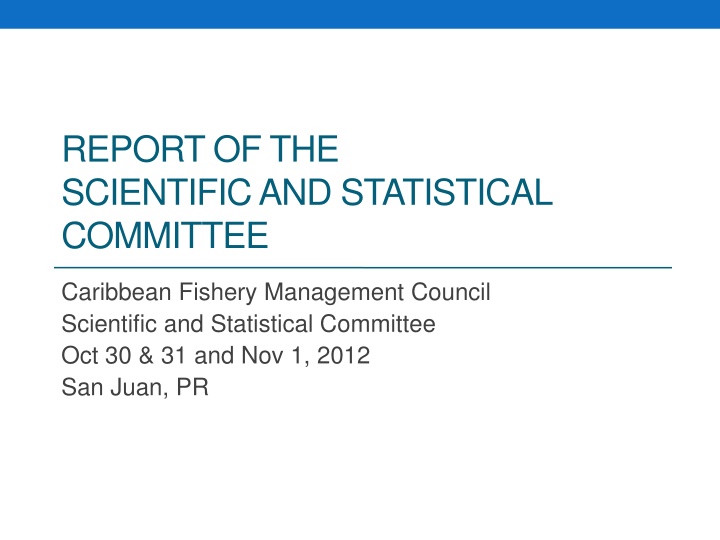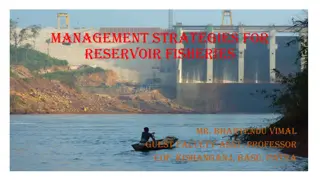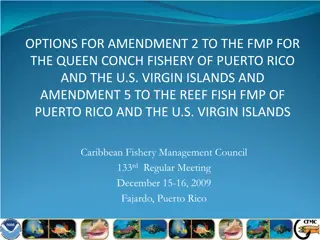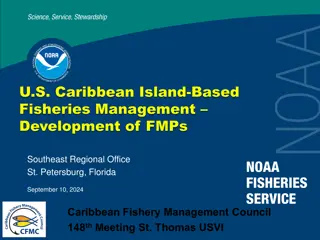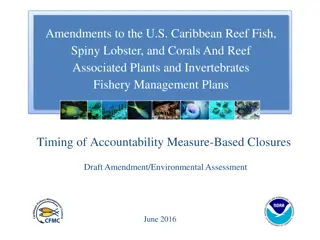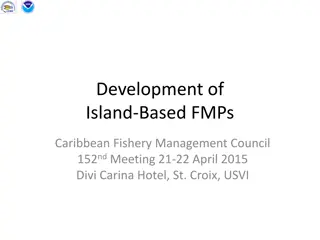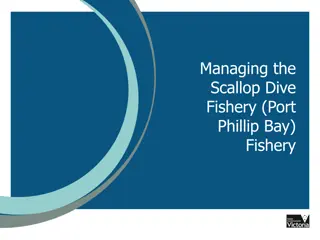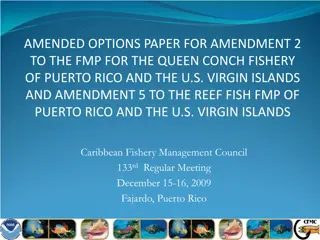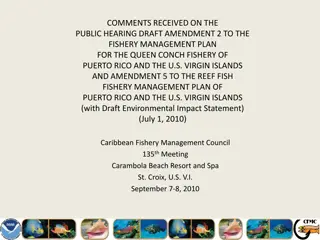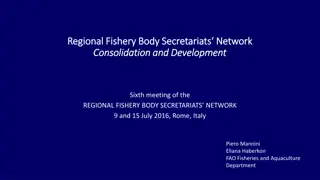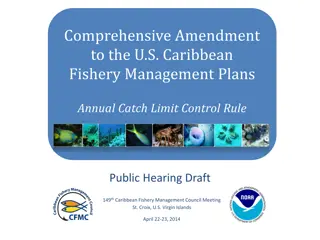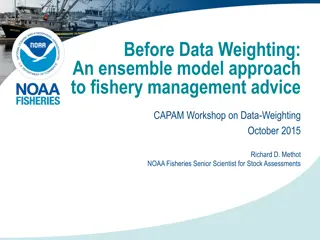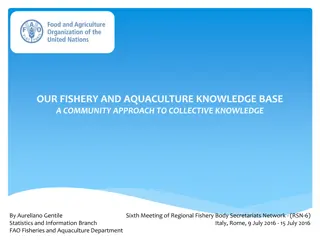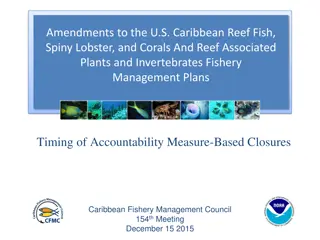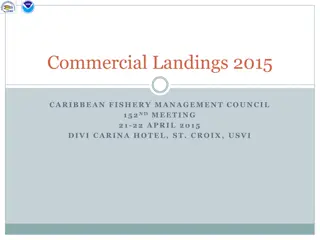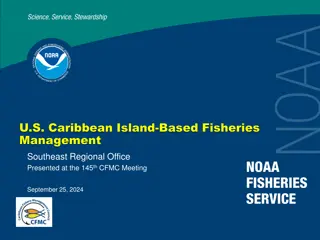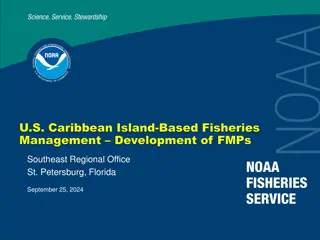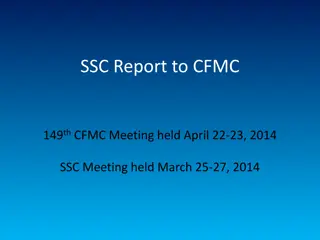Caribbean Fishery Management Council Scientific and Statistical Committee Report 2012
The Scientific and Statistical Committee (SSC) of the Caribbean Fishery Management Council reviewed species units with Annual Catch Limits (ACL) overages and discussed research priorities. When ACLs are exceeded, accountability measures are triggered, leading to a reduction in the fishing season. The report highlighted specific species and their percentage over ACLs, emphasizing the importance of data accuracy in determining ACL exceedances. Additionally, the SSC examined ACLs for species units not designated as overfished or undergoing overfishing. The annual recreational landings for certain species were also assessed, indicating potential issues with data variability and precision.
Download Presentation

Please find below an Image/Link to download the presentation.
The content on the website is provided AS IS for your information and personal use only. It may not be sold, licensed, or shared on other websites without obtaining consent from the author.If you encounter any issues during the download, it is possible that the publisher has removed the file from their server.
You are allowed to download the files provided on this website for personal or commercial use, subject to the condition that they are used lawfully. All files are the property of their respective owners.
The content on the website is provided AS IS for your information and personal use only. It may not be sold, licensed, or shared on other websites without obtaining consent from the author.
E N D
Presentation Transcript
REPORT OF THE SCIENTIFIC AND STATISTICAL COMMITTEE Caribbean Fishery Management Council Scientific and Statistical Committee Oct 30 & 31 and Nov 1, 2012 San Juan, PR
Outline Review of species units with ACL overages 5 year research priorities Reviewed letter from CFMC to NMFS regarding proposal to list queen conch
What happens if Annual Catch Limits (ACLs) are exceeded? When ACLs are exceeded, accountability measures (AMs) are triggered, resulting in a reduction of the fishing season for that species/species group. AMs are not triggered if NMFS, in consultation with the CFMC and SSC, determines that the overage occurred because data collection and monitoring improved rather than because catches actually increased.
SSC reviewed list of Species / Species Units that had exceeded their ACL The ACLs for species units that were designated overfished or undergoing overfishing was determined in 2010. The determination of whether the ACL had been exceeded for these species was based on the average of the annual commercial landings for 2010 & 2011. Note that landings values provided by the SEFSC were tentative at the time of the SSC meeting. Annual Catch Limit Species Landings (lbs) Percent Over ACL Puerto Rico average annual commercial landings for 2010 & 2011 Snapper Unit 2 (queen and cardinal snapper) St. Croix average commercial landings for 2010 & 2011 Queen conch 66,896 St. Thomas/St. John average commercial landings for 2010 & 2011 Grouper 56,833 301,988 145,916 107.0% 50,000 33.8% 51,849 9.6%
Species units reviewed continued ACLs for species units that were not designated overfished or undergoing overfishing were established in 2011. The determination if the ACLs for these species was exceeded is based on only 2011 annual landings. Landings (lbs) Annual Catch Limit Percent over ACL PSE for AB1 Species Puerto Rico average annual recreational landings for 2011 Wrasses (hogfish, Spanish hogfish, puddingwife) 5,538 5,050 9.7% 70 PSE (Proportional Standard Error) is a measure of the variability of the data. PSE s higher than 25 should be viewed with caution and those above 50 indicate high variability and low precision.
Annual landings of recreational species are estimated based on the results of recreational intercept surveys (catch data) and telephone surveys (effort data). Number of fish caught with different gear types Total number of intercepts that recorded at least one of wrasse unit species Year Hook and Line Fishing Spear Fishing Yo-yo Gear 7 9 5 2 8 2 2 9 2000 2001 2002 2003 2004 2005 2006 2007 2008 2009 2010 2011 Total 1 18 7 16 8 2 0 1 6 8 8 5 88 12 2 2 1 Table 3. Annual number of intercepts that reported one of the wrasse species in the ACL unit. 6 1 1 5 6 2 3 1 2 6 2 Note: Number of wrasse intercepts are generally low 51 31 6
SSC review of overage of recreational wrasse ACL for Puerto Rico PR DNER provided the following information: Hogfish are the most important wrasse species landed by recreational fishers in Puerto Rico Spearfishing was thought to be the method used for most of the catch of hogfish Hogfish (Capitan) is considered a prized trophy fish among recreational fishers in PR It was thought that spearfishing had increased significantly since 2009, especially through the development of a kayak based fishery, which the MRFSS sampling had not fully sampled.
Recreational wrasse landings WRASSE ACL is 5,050 lbs. 35000 ACL was exceeded by 9.7 % or 488 lbs. 30000 25000 Wrasse landings peaked in 2008 and have declined steadily since then. Estimated lbs 20000 This decline occurred at a time at a time when effort was thought to have increased. It is not clear if increasing effort has led to the observed decline in the stock biomass. 15000 10000 5000 The SSC made recommendations for further analysis of wrasse data. 0 2000 2001 2002 2003 2004 2005 2006 2007 2008 2009 2010 2011 2012 Note: data incomplete for 2012.
SSC Conclusions - wrasse Based on these considerations, there is no substantiated evidence to support the idea that the observed overage is due to any methodological changes in data collection or behavior of the fishery. Kojis emphasis However, important to take into account that the overage is small (488 lbs or 9.7%) and error (PSE) in the estimate of landings high.
Commercial queen conch landings St. Croix St. Croix reported conch commercial landings 250,000 200,000 Landings in pounds whole weight ACL is based on average of 2010 and 2011 landings data 150,000 ACL was exceeded by 33% because of 2010 landings 100,000 Landings in 2011 were at the ACL level 50,000 0 1998 1999 2000 2001 2002 2003 2004 2005 2006 2007 2008 2009 2010 2011 Conch Conch ACL
St. Croix trips and fishers with reported conch commercial landings Queen conch trips and fishers 3,500 70 3,000 60 Number of trips track landings Number of reporting fishers Number of reported trips 2,500 50 Number of fishers reporting varied over the years 2,000 40 There was no evidence from the number of fishing trips and number of fishers reporting in 2000 2011 that there have been any significant changes in reporting by fishers. 1,500 30 1,000 20 500 10 It is clear that there was a peak in reported landings in 2006 of approximately 240,000 lbs and a subsequent fairly rapid decline, apparently reaching the ACL by 2011. 0 0 1998 1999 2000 2001 2002 2003 2004 2005 2006 2007 2008 2009 2010 2011 Trips Fishers
ACL overage for queen conch on St. Croix Based on average landings data from 2010 and 2011, the ACL was exceeded by 33% (68% in 2010 and 0% for 2011). It was noted at the SSC meeting that 2011 data needed to be verified to ensure it is the final total. The Division of Fish and Wildlife keeps track of queen conch landings and closes the queen conch fishery once submitted catch reports show the ACL has been reached. The 2010 overage occurred, at least in part, because the ACL was reached before all catch reports had been submitted. It looks like this has been corrected in 2011.
SSC Recommendations SSC noted that conch landings peaked in 2006 and rapidly declined to nearly the ACL level in 2011. Kojis emphasis - It appears that monitoring of queen conch landings and the closure of queen conch fishery to ensure the ACL is not exceeded is improving. SSC noted that preliminary data from a survey by Hill et al. confirmed that St. Croix harbors a significantly higher density of juvenile and adult queen conch compared to STT/STJ and PR The SSC recommends that the SEFSC determine the density levels of queen conch adults and juveniles that need to be achieved in order to increase the ACL for queen conch in the US Caribbean.
Commercial Grouper unit landings St. Thomas St. Thomas/St. John reported grouper commercial landings 80,000 70,000 ACL of 51,849 lbs was based on average landings of from 2000- 2005 (OFL) and with 15 % reduction. 60,000 Landings in pounds 50,000 40,000 The ACL was exceeded by almost 5,000 lbs or 9.6% 30,000 20,000 Landings declined from 2009 to 2011 but remained above the ACL level 10,000 0 2003 2000 2001 2002 2004 2005 2006 2007 2008 2009 2010 2011 Groupers Grouper ACL
Grouper unit St. Thomas trips and fishers St. Thomas/St. John trips and fishers with reported grouper commercial landings 2,500 120 100 The number of fishers reporting varied only slightly between 2000 and 2010, but increased dramatically, by about 90%, in 2011. 2,000 Number of reporting fishers Number of reported trips 80 1,500 60 The number of trips with reports of grouper increased from 2000 to 2004 and declined slowly after that except for 2009. 1,000 40 500 20 0 0 2000 2001 2002 2003 2004 2005 2006 2007 2008 2009 2010 2011 Trips Fishers
SSC Conclusions - grouper Since the total grouper landings declined in 2010 and 2011, along with the number of fishing trips, it is unlikely that an increase in the number of fishers reporting was responsible for the 2011 grouper landing overage. While a change in the dynamics of reporting was observed during 2011, its implications on total grouper landings remain unclear. The SSC concluded that there was insufficient evidence that enhanced data collection or monitoring efforts significantly contributed to the grouper overage in 2010 and 2011.
Snapper unit 2 Puerto Rico Commercial Landings Puerto Rico snapper units 2 commercial expanded landings 400,000 350,000 Landings in pounds whole weight Based on expanded landings data, the ACL of 145,916 lbs was exceeded by 156,072 lbs or 107%. 300,000 250,000 200,000 It was exceeded in both 2010 and 2011. 150,000 100,000 Because of lack of staff at the Puerto Rico Fisheries Lab in 2010, the expansion factor 2009 was used in 2010 (Fig. 7). The expansion factor for 2011 was based on surveys conducted in 2011 of fishers and their catch. 50,000 0 1999 2000 2001 2002 2003 2004 2005 2006 2007 2008 2009 2010 2011 SnappersUNIT 2 ACL UNIT 2
Puerto Rico landings expansion/correction factors by coast and year PR Expansion factors 1.00 Expansion/correction factor 0.80 Estimated landings or expanded landings are obtained by dividing landings by the expansion factor. 0.60 0.40 For example, if the reported landings in 2006 and 2011 were 100,000 lbs in both years, but the expansion factor was 0.5 in 2006 and 0.8 in 2011 then the expanded landings in 2006 would be 100,000/0.5 = 200,000 lbs and in 2011 would be 100,000/0.8 = 125,000 lbs. 0.20 0.00 1999 2000 2001 2002 2003 2004 2005 2006 2007 2008 2009 2010 2011 islandwide north east west south
Changes affecting expansion annual factors Starting in 2011, the Secretary of DNER allowed fishers to submit trip reports after the 60 day deadline. Prior to 2011, trip reports were not accepted if submitted 60 days after a fishing trip. Thus in 2011 the number of trips increased due to the change in regulations. However, the correction factor used to expand the landings, took this increase in number of trips into account.
Puerto Rico trips and fishers with reported snapper unit 2 commercial landings - not expanded Snapper Unit 2 PR 3,500 300 3,000 250 Number of reporting fishers There were fewer trips with reported Snapper Unit 2 after 2002. However, the number of trips increased between 2009 and 2011. Number of reported trips 2,500 200 2,000 150 1,500 100 1,000 The number of fishers reporting (unexpanded) almost doubled between 2009 and 2010 and then declined in 2011. 50 500 0 0 1999 2000 2001 2002 2003 2004 2005 2006 2007 2008 2009 2010 2011 Trips Fishers
CPUE (Catch per Unit Effort) The CPUE remained steady
SSC Conclusions Because Puerto Rico generally calculates annual correction/expansion factors for four distinct coastal areas around Puerto Rico it appears that the overage is real and not owing to enhanced data collection and monitoring efforts. The increase in landings in 2010 and 2011 could be explained if stocks have increased or fishers have gone further afield to harvest unexploited stocks. Based on all of the above, the SSC concludes that the overage is real given the data presented, which we understand to be the best available. However, we feel that the data for 2010 may be less accurate than years for which the correction factor was directly calculated and this may have impacted the results.
SSC Concerns Correction/Expansion Factor In 2010, the correction factor was not directly calculated and that for 2009 was used. Landings for 2010 showed the largest overage for Snapper Unit 2. Correction factors are historically variable and their accuracy may have a large impact on the expanded landings, affecting the estimation of ACL overages, both in their occurrence and extent.
More SSC Concerns Possible fishing area expansion General impression that the fishery for Snapper Unit 2 experienced a significant expansion in the area fished over the past decade or more. If true, expect the ACL would not have been based on the full potential of the fishery. As a consequence overages would be expected to occur that would not be related to any change in stock status. The SEDAR assessment conducted in 2011 for queen snapper showed a significant increase in the mean size of fish landed in recent years and concluded that queen snapper were not undergoing overfishing. This trend is consistent with an expansion in the area fished, although other explanations are also possible. Unfortunately, there are no data publicly available to verify if such an expansion in the area fished has occurred. This would be necessary for any re-evaluation of the ACL though the SSC felt fishermen may have the needed information.
5-year Priority Research Needs Revised outline based on Dr. Mike Sissenwine s recommendations There was insufficient time discuss this further. SSC members agreed to work on fleshing out the outline and provide a Draft of their section by December 20, 2012 The SSC needs to meet at least once more to review the research needs and prioritize them
Queen conch listing The SSC reviewed the letter from the CFMC to NMFS and concurred with the CFMC opinion that queen conch not be listed under the ESA based in part on the fact that queen conch receives enough protection to ensure its preservation.
